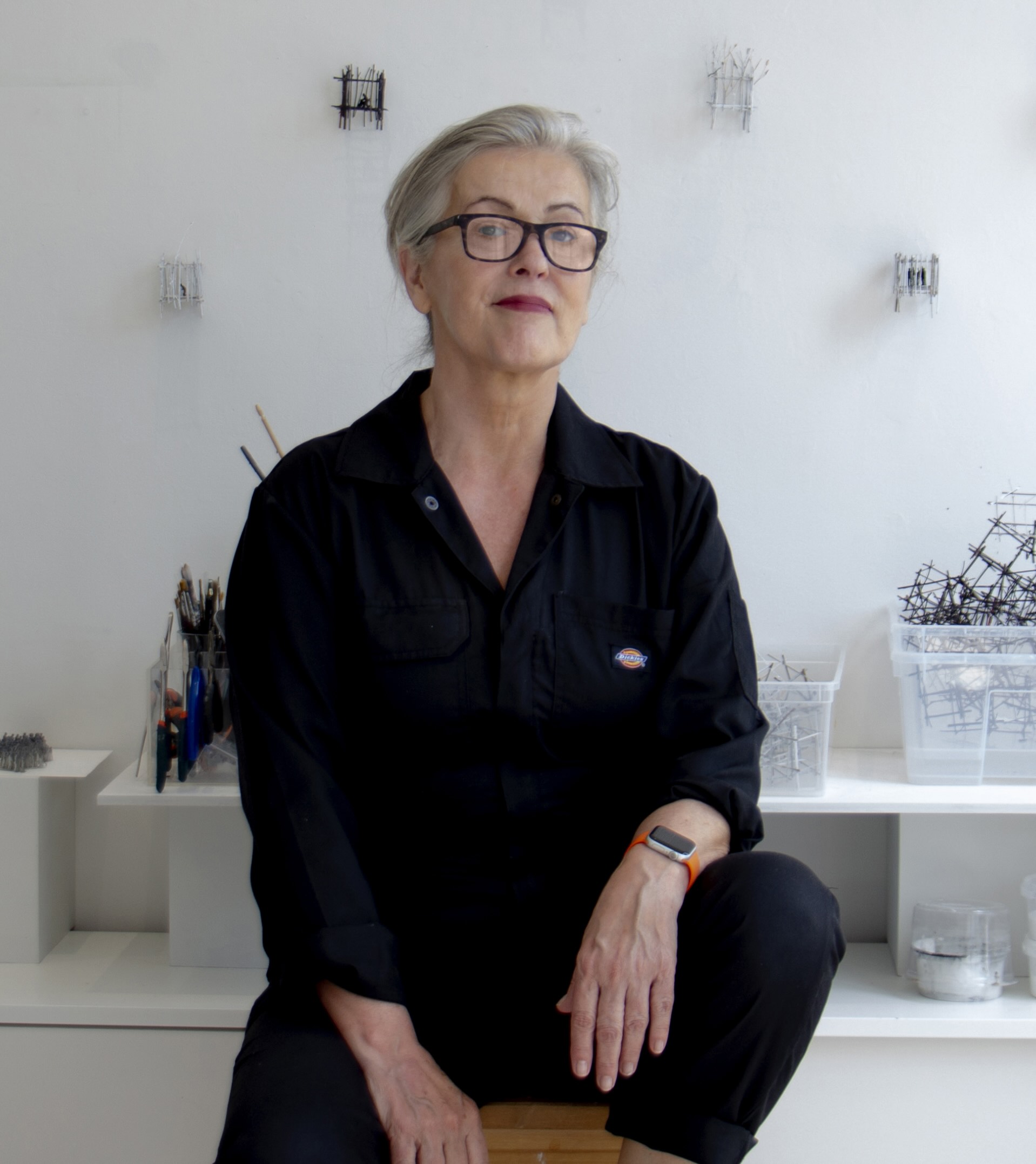“To the Edge of Your World” is the intriguing title of a new exhibition by Anita Groener at the Academy Art Museum where she was its 2024 artist-in-residence. But in my initial walkthrough at the opening reception on Saturday, Aug. 16, I found the show – consisting of delicate constructs (I hesitate to call them sculptures) and drawings punctuated by a checkerboard gouache on paper – visually underwhelming. But my first impression was devoid of context aside from the brief wall-label introduction, which mentioned another premiere that day – this of an accompanying animated video, “Shelter,” inspired by highly personal narratives of residents at the Talbot Interfaith Shelter homes on Goldsborough Street in Easton.

Context makes all the difference in this exhibit of works by the Dutch-born and now Ireland-based artist. Here, Groener deploys appropriately common materials – twigs, cardboard and paper – to reflect the edgy themes suggested in the title: the everyday impact on those directly or indirectly affected by conflict, migration and remembrance of what is left behind as well as trepidation about what lies ahead. At the reception, “Shelter,” the stop-motion animation by Groener in collaboration with documentary filmmaker Matt Kresling in partnership with TIS was shown on a wide screen to a full-capacity audience in the museum’s auditorium. During the run of the exhibition through Oct. 26 visitors can view up close on a video screen in the lobby.
One of the themes that instantly came to my mind as I entered the museum’s Lederer Gallery was “Shelter,” a piece by the same name that looked like anything but. Rather, it resembles a series of cages for imprisoned migrants like those in some border-state detention facilities and on Florida’s notorious Alligator Alley. A series of small drawings bookended by a pair of larger gouache images incorporating bits of twine enigmatically titled “At the Still Point of the Turning World” and “I am Here Because You Are There” leands you toward the gallery back wall lined with tiny stick-constructed objects resembling baby cribs or tree houses, some sprouting leafy saplings and others inhabited by human stick figures. Stick objects on a long table seem to be waiting for assembly into something more than the sum of their parts. We can only guess what.

Anita Groener
Nearby, you are invited to leave written comments about what you have seen. But before you do, check at least a few segments of the animated “Shelter” video for the context I was lacking at first. You’re not expected to stand through the full half hour in front of the screening of “Shelter,” which runs in loops during museum hours. The imagery constructs and then deconstructs rectangular stands of sticks amid a growing gathering of humans while at other times forming a patch of trees blowing in the wind. Each such scene is accompanied by vocal recordings of TIS residents telling how they became homeless – each very relatable in the sense that – as the saying goes – “there but for the grace of God [or whomever] go I.” Death of a parent or spouse, loss of employment after 22 years, addiction to pain killers after an accident or by self-medication, whether by alcohol or drugs. Each story is separated by photographic images from the artist’s past, usually including a baby or young child and a parent or other relative.
After viewing a few of these vignettes, return to Anita Groener’s exhibit to see what you may have missed at first glance. I missed a lot. But that’s just me. Maybe you’ll be more intuitive.
***
While you’re at the museum, walk across the hall to the Healy Gallery for “Fields, Voids, and Translations,” a show of works on paper and textiles by Piper Shepard. A Baltimore-based artist, Shepard specializes in large-scale works – she calls it “architectural scale” – such as weavings that mimic botanical or even celestial imagery. My favorite was “Soft Light Shifting,” a handcut lunar graphic that casts a full-moon shadow on the wall a foot or so behind it, bringing to mind a solar eclipse if you’re at the right place and time for such an event. Three squarish black-and-white prints on paper offer “Textile Translations” from fabric to art on the far wall from the moon.
In the hallway Atrium between the AAM’s main galleries, stop long enough to take in and contemplate Anne Lindbergh’s commissioned site-specific piece called “seen and unseen.” The most easily “seen” portion are three drawings in parallel lines of complementary colors. These reflect shades that are largely “unseen” until you stand against the north wall of the natural-light Atrium and look up through an opening toward the second-story ceiling. A luminous sculpture of chromatic threads creates a rainbow effect in earth-and-sky hues that can be seen both above and below. But you’ll need to climb the stairs to the upper hallway gallery and stroll back to the far wall to discern whether the colors take on a different shade from on high. See for yourself.
ART, ANIMATION, ATRIUM & FIBER IMAGERY
Anita Groener’s “To the Edge of Your World” and “Shelter” video, through Oct. 26; Piper Shepard’s “Fields, Folds, and Translations, through Oct. 12; Anne Lindbergh’s “seen and unseen” installation, through the fall of 2026, all at Academy Art Museum, 106 South St., Easton, Tuesdays-Sundays, free admission, academyartmusuem.org
Steve Parks is a retired New York arts critic now living in Easton.



Write a Letter to the Editor on this Article
We encourage readers to offer their point of view on this article by submitting the following form. Editing is sometimes necessary and is done at the discretion of the editorial staff.